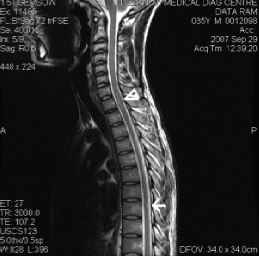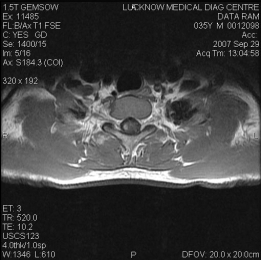Annals of Neurosciences, Vol 15, No 1 (2008)
Annals of Neurosciences, Volume 15, Issue 1 (January), 2008
BROWN-SÉQUARD'S SYNDROME PRODUCED BY HEMICORD MYELITIS- A CASE REPORT
Corresponding Author
Dr RK Garg
Professor
CSM Medical University, Lucknow
(Date recieved : 17.11.07)
Abstract
Brown-Sequard Syndrome is most commonly described in conjunction with a traumatic injury to the spinal cord. Extramedullary spinal neoplasm, cervical disc herniation, spinal epidural hematoma, multiple sclerosis and myelitis are reported as uncommon causes.
A 35 years old male patient who presented with history of acute onset pins and needle sensations over left lower limb. Examination revealed fifty percent loss of pin prick and hot and cold sensation on left side of the body below T8 dermatome with sharp midline margin and subtle weakness of right lower limb along with absent abdominal reflexes on right side and extensor plantar on right side. MRI of thoracic cord revealed a T2 hyperintense lesion at T8 level of spinal cord which enhanced with gadolinium contrast suggestive of right hemicord myelitis.
Brown-Sequard Syndrome can be caused by idiopathic myelitis. Early manifestations of myelitis may be subtle and should not be confused with functional disorder. Patient must be repetitively examined and followed with other necessary investigative modalities.
Key words: Brown-Sequard Syndrome, Idiopathic myelitis.
Introduction
Brown-Sequard syndrome is an incomplete spinal cord lesion characterized by ipsilateral loss of motor function, proprioception and vibratory sensation, combined with contralateral loss of pain and temperature sensation. It is most commonly described in conjunction with a traumatic injury to the spinal cord. Extramedullary spinal neoplasm, cervical disc herniation, spinal epidural hematoma, multiple sclerosis and myelitis are reported as uncommon causes (1–5). We here by report a case of hemicord myelitis presenting with isolated sensory loss below left trunk.
Case report
A 35 years old male patient presented with history of acute onset pins and needle sensations over left lower limb. There was reduced feeling of hot water on left lower limb. He had no history of weakness, bladder symptoms, back pain, thinning of limbs, trauma or fever. He was working as a paramedical staff in a primary health centre. On examination he was of average built with normal general physical examination. Higher mental functions and cranial nerves were normal. Motor system examination, deep tendon reflexes and superficial reflexes were normal. Plantars were flexor. Sensory system examination revealed fifty percent loss of pin prick and hot and cold sensation on left side of the body below T8 dermatome with sharp midline margin. Sensory loss was same in intensity on both posterior and anterior aspect of left side trunk and left lower limb. Testing to joint position, vibration and fine touch was normal. Examination of gait, straight leg raising test and examination of back was normal. In view of these findings, a possibility of hysterical hemisensory loss was kept and patient was kept under observation for few more days. On third day, a repeat examination revealed subtle weakness(MRC grade 4) of right lower limb in form of difficulty in hopping on right leg along with absent abdominal reflexes on right side and extensor plantar in right side. This prompted us to get an MRI of thoracic cord done which revealed a T2 hyperintense lesion at T8 level of spinal cord which enhanced with gadolinium contrast (Fig 1 & 2). Hematological and biochemical parameters were within normal limits. ANA and ELISA for HIV were negative. Cerebrospinal fluid analysis showed <5 cells/cmm, protein- 39 mg/dl and sugar-58mg/dl (corresponding blood sugar 96 mg/dl). A revised diagnosis of Brown-Séquard syndrome like idiopathic hemicord myelitis was made and injection methylprednisolone 1 gram per day was given for five days. Patient improved and was asymptomatic at 7th, 21st and 90th days of follow up.

Fig. 1. T2 FLAIR MRI image of sagittal section of cervico-thoracic cord. Hyperintense lesions present at T1 and T8 levels as shown by closed and open arrows respectively.

Fig. 2. Gadolinium- enhanced T1 MRI image of axial section of cord at T8 level showing contrast enhancement of lesion.
Discussion
Our patient was initially diagnosed as having functional sensory loss due to presence of isolated loss of pin prick sensation over left side of trunk and left lower limb with sharp midline and horizontal margins. His symptoms progressed and subsequently a diagnosis of Brown-Séquard syndrome like idiopathic hemicord myelitis was made. Brown-Sequard syndrome is an incomplete spinal cord lesion characterized by ipsilateral loss of motor function, proprioception and vibratory sensation, combined with contralateral loss of pain and temperature sensation. It is most commonly described in conjunction with a traumatic injury to the spinal cord. Extramedullary spinal neoplasm, cervical disc herniation, spinal epidural haematoma and multiple sclerosis are reported as uncommon causes (1–4). Although few cases of infective myelitis have been reported as incomplete Brown Sequard syndrome, idiopathic myelitis presenting as Brown sequard syndrome has probably not been reported (5–6).
Early manifestations of myelitis may be subtle and unusual with atypical symptoms and signs at the time of presentation. Little objective data may be found in neurological examination causing confusion with functional disease. Functional sensory disturbance may have sharply demarcated boundaries at the shoulder, trunk or groin. If the trunk is involved, the front is more commonly involved than the back. While various functional sensory signs have been described, none appear to be specific and they should not therefore be used to make a diagnosis (7–9). It has been commonly assumed that exact splitting of sensation in the midline cannot occur in organic disease. The reason usually given is that cutaneous branches of the intercostals nerves overlap from the contralateral side, so sensory loss should be paramedian i.e. 1 or 2 cm from the midline. However, midline splitting can occur in thalamic stroke with profound loss of several sensory modes, resembling a functional sensory loss (10). Rolak reported midline splitting in six of 80 patients with organic disease (11).
Physicians must be careful in attributing such symptoms to psychiatric disorders. Above mentioned case is an example of such a problem, representing a rare case of myelitis presenting as hemisensory loss with sharp margins progressing to manifest as Brown-Séquard like syndrome. Examination at the time of presentation had revealed only subjective hemisensory loss. However, repeated careful examination after three days revealed organic type of motor weakness on opposite side with extensor plantar. Also, this reinstates the age old teaching that sensory loss on one side and motor weakness on other side usually suggest an organic disease. It is concluded that atypical symptoms and signs must not automatically attribute to conversion reaction, and for such a diagnosis we must adhere to strict diagnostic criteria. In such situation, spending a few more days for accurate neurological examination may provide valuable information and a correct diagnosis.
References
1. Egido Herrero JA, Saldana C, Jimenez A, et al. Spontaneous cervical epidural hematoma with Brown-Sequard syndrome and spontaneous resolution. Case report. J Neurosurg Sci 1992; 36: 117–9.
2. Finelli PF, Leopold N, Tarras S. Brown-Sequard syndrome and herniated cervical disc. Spine 1992; 17: 598–600.
3. Henderson SO, Hoffner RJ. Brown-Sequard syndrome due to isolated blunt trauma. J Emerg Med 1998; 16: 847–50.
4. Kraus JA, Stuper BK, Berlit P. Multiple sclerosis presenting with a Brown-Sequard syndrome. J Neurol Sci 1998; 156: 112–3.
5. Titlic M et al. Diagnostics of incomplete Brown Sequard syndrome caused by meningococcal myelitis. Bratisl Lek Listy 2006; 107:287–9.
6. Mukai E et al. A case of varicella zoster virus myelitis presenting with Brown-Sequard syndrome. Neurological Medicine 2005; 62: 481–6.
7. Stone J, Zeman A, Sharpe M. Functional weakness and sensory disturbance. J Neurol Neurosurg Psychiatry 2002;73: 241–5.
8. Stone J, Carson AJ, Lewis S, et al. Laterality of unexplained motor and sensory symptoms. J Neurol Neurosurg Psychiatry 2002;72:133.
9. Janet P. The major symptoms of hysteria. London: Macmillan, 1907.
10. Vuilleumier P, Chicherio C, Assal F, et al. Functional neuroanatomical correlates of hysterical sensorimotor loss. Brain 2001;124:1077–90.
11. Rolak LA. Psychogenic sensory loss. J Nerv Ment Dis 1988;176:686–7.
(c) Annals of Neurosciences.All Rights Reserved